How to make kudzufu?
1. Harvest
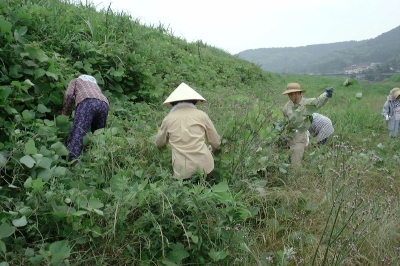
From June to August, kudzu plants grow new vines up to 2-3 meters in length. These fresh, green-colored vines are the size of a woman's little finger and have tiny hairs on their surface. We carefully select vines that stretch straight from dark to bright, avoiding those that tangle around tree trunks or have too many sub-branches. To harvest, we cut the leaves off from the root side to the top and then make wreaths using 5-8 vines.
2. Boil
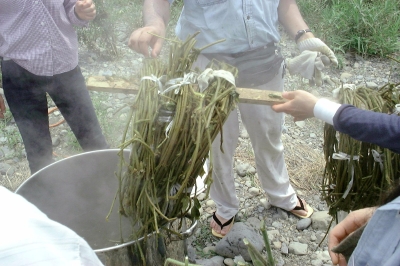
We boil the kudzu vine wreaths as soon as possible after harvest. In case we cannot boil them immediately, we put them in water to prevent drying in sunlight. The wreaths are boiled in a giant cauldron for approximately 20 minutes. During this process, the wreaths emit a pleasant aroma of boiled green soybeans and turn a vibrant green color. As the boiling process continues, the color gradually changes from green to yellow, indicating the ideal time to remove them from the cauldron. After boiling, we put them in water to cool down.
3. Fermentation
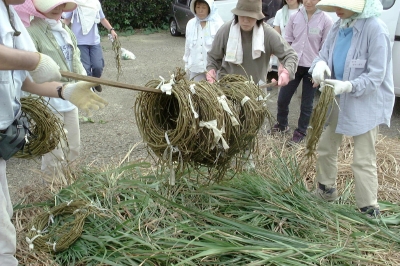
We cut silver grass leaves and lay them on the ground, then place the kudzu vine wreaths on top. The silver grass leaves should thoroughly cover the wreaths. Next, we put a straw mat over the silver grass leaves and weigh it down with stones to create a mound. After 4-5 days, we check if the kudzu's outer skin has become slimy by placing our hands into the grass mound. If it has, we take the vine out from the grasses.
4.Wash
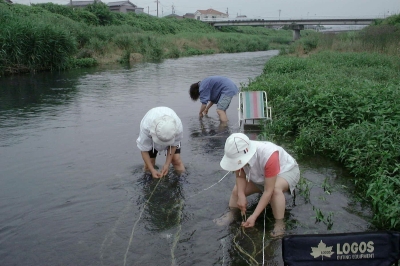
We rinse off the slimy outer skin of the kudzu vine in a river.
5. Fukuronuki
We grab the bottom of the vine and remove the bast from its core, then wash it thoroughly to ensure its quality remains intact.
6. Dry
We dry these bast fibres straight on the river shore. These bast fibres from the kudzu vine are known as "Kudzuo"..
7. Making tsuguri
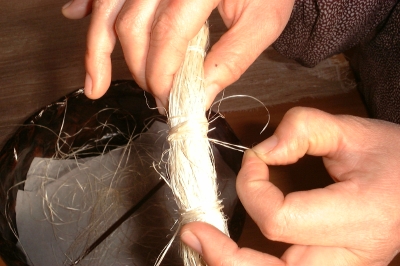
We split the kudzu bast fibres into threads that are 1-2mm in width and tie the edges of two threads with a "Kudzu Knot". These tied threads are then put into a basket, which helps to lengthen them. Once the basket is full of threads, we turn it upside down to take the threads out. Next, we put a cup of rice bran on the thread mound and make a figure 8 with the threads around a chopstick. When it becomes the size of a young cucumber, we stop making the figure 8 and tie it at three places before pulling the chopstick out of the threads. This final product is called "Tsuguri".
8.weaving
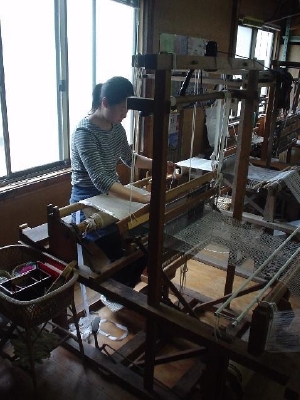
Almost all kudzufu is woven using plain weaving. Kudzu weaving is so delicate that it can only be done by hand. The fluffs on its surface must be carefully cut off using scissors. Then, the fabric is beaten with a wooden comb (a process called "Kinutauchi") to add shine and softness.
Remarks
The harvest time for kudzu is from late May to early August. However, the best time to harvest in this region is July. The exact harvest season may vary depending on the climate of the year.
Silver grass leaves have many Bacillus bacteria on their surface, which can promote the fermentation of kudzu. Bacillus bacteria are most active at a temperature of 37℃, which is almost the same as the human body temperature. These bacteria can decompose cellulose and soften the kudzu fiber without damaging it, allowing the fiber to maintain its beautiful shine. When the fermentation process is in good condition, white mold can be seen on the surface of the kudzu vine. This white mold is the spore of Bacillus bacteria and indicates that the fermentation process has been completed.
The best way to obtain high-quality fiber is to wash the kudzu vines in a river with pure water. If washed with tap water, the fibers may become tangled and lose their shine.
When beating the reed, it should be driven at a slant against the warp to prevent the kudzu threads from being crushed.
Those who work with Yaeyama jo-fu and Basho-fu make threads into cocoon shapes for the weft. However, when using cocoon-shaped threads, the weft may tend to twist when pulled out from a shuttle. To avoid this issue, kudzu threads are made into cucumber-shaped tsuguri for the weft to prevent them from becoming twisted.
The rear beam of a Kudzufu loom is typically positioned lower than the front beam to prevent the kudzu threads from being crushed during the weaving process. Additionally, the reed used in Kudzufu looms is lighter than those used in standard looms.
